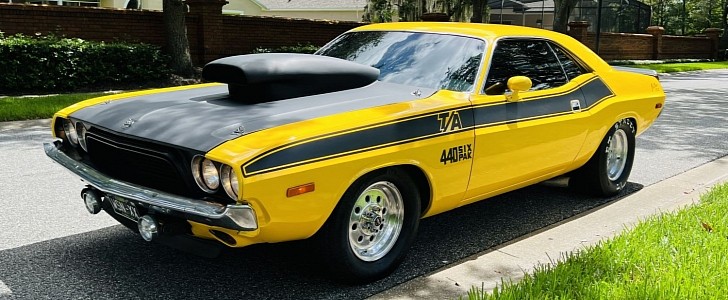Introduced for the 1970 model year, the first-generation Dodge Challenger was short-lived, leaving dealerships after only five years. But that was enough to establish itself as an iconic nameplate of the golden muscle car era.
In fact, the Challenger needed only a couple of years to impress. I'm talking about 1970 and 1971, when the pony was offered with the optional 426-cubic-inch (7.0-liter) HEMI and the 440-cubic-inch (7.2-liter) RB V8s. Not only were these mills discontinued for 1972, but power ratings also went down across the entire engine lineup.
As a result, the 1970 and 1971 Challenger are the most popular iterations of the first-gen muscle car and get a lot more attention from collectors nowadays. And needless to say, they also fetch a lot of cash when in Excellent condition and with the proper V8 under the hood.
This 1972 Challenger is not one of those cars, but it's not a mundane Malaise-era rig either. That's because it's no longer a stock pony with an underpowered 340-cubic-inch (5.6-liter) V8 under the hood. This Challenger is a full-blown custom that's ready to impress not only on public roads but also at the drag strip.
Yes, I know, Dodge didn't offer a T/A in 1972, and the misspelled "440 Six Pak" decals on the fenders are a tad silly, but we need to look beyond that because this Challenger hides a monster under the lift-off fiberglass hood with the massive scoop in the center.
The mill in question is a 540-cubic-inch (8.8-liter) V8 of the RB variety coming from Indy Cylinder Heads. Sporting a long list of upgrades, including a dual-plane intake manifold and a Holley Mighty Demon carburetor, the powerplant generates a whopping 720 horsepower and 680 pound-feet (922 Nm) of torque. A solid improvement over the car's previous 340 V8, rated at 240 horsepower, don't you think?
All that oomph travels to the rear wheels through a 727 three-speed automatic transmission with a 3,500-rpm-stall torque converter and a 4.10-geared Dana 60 rear axle and hits the asphalt through a set of Mickey Thompson E/T tires.
The engine is also set up for nitrous oxide, with a separate fuel cell, fuel pump, solenoids, and wiring, but it has not yet been fully completed. All told, this Challenger is only a few upgrades away from becoming a very competitive drag racer.
Drivetrain-aside, the car doesn't look very different than the regular 1972 Challenger beyond the T/A stripes, the scoop, and the drag-spec wheels. But it does sport a Prowler Yellow paint that wasn't available in 1972 (the car was Light Gold from the factory) and 'Cuda-style foglamps.
Not surprisingly, the cabin was prepped for racing weekends through bucket front seats with multi-point harnesses, a padded roll cage, and Auto Meter gauges. The rear bench is still in place, so the Challenger is still suitable for more than two people.
With only 4,326 miles (6,962 km) on the clock and located in Orlando, Florida, this beefed-up 1972 Challenger is looking for a new home with a $58,000 sticker via Hemmings. That's a bit more than a 1972 model in Concours condition, but also with a lot more extra oomph to throw around. And it sounds nasty too.
As a result, the 1970 and 1971 Challenger are the most popular iterations of the first-gen muscle car and get a lot more attention from collectors nowadays. And needless to say, they also fetch a lot of cash when in Excellent condition and with the proper V8 under the hood.
This 1972 Challenger is not one of those cars, but it's not a mundane Malaise-era rig either. That's because it's no longer a stock pony with an underpowered 340-cubic-inch (5.6-liter) V8 under the hood. This Challenger is a full-blown custom that's ready to impress not only on public roads but also at the drag strip.
Yes, I know, Dodge didn't offer a T/A in 1972, and the misspelled "440 Six Pak" decals on the fenders are a tad silly, but we need to look beyond that because this Challenger hides a monster under the lift-off fiberglass hood with the massive scoop in the center.
The mill in question is a 540-cubic-inch (8.8-liter) V8 of the RB variety coming from Indy Cylinder Heads. Sporting a long list of upgrades, including a dual-plane intake manifold and a Holley Mighty Demon carburetor, the powerplant generates a whopping 720 horsepower and 680 pound-feet (922 Nm) of torque. A solid improvement over the car's previous 340 V8, rated at 240 horsepower, don't you think?
All that oomph travels to the rear wheels through a 727 three-speed automatic transmission with a 3,500-rpm-stall torque converter and a 4.10-geared Dana 60 rear axle and hits the asphalt through a set of Mickey Thompson E/T tires.
The engine is also set up for nitrous oxide, with a separate fuel cell, fuel pump, solenoids, and wiring, but it has not yet been fully completed. All told, this Challenger is only a few upgrades away from becoming a very competitive drag racer.
Drivetrain-aside, the car doesn't look very different than the regular 1972 Challenger beyond the T/A stripes, the scoop, and the drag-spec wheels. But it does sport a Prowler Yellow paint that wasn't available in 1972 (the car was Light Gold from the factory) and 'Cuda-style foglamps.
Not surprisingly, the cabin was prepped for racing weekends through bucket front seats with multi-point harnesses, a padded roll cage, and Auto Meter gauges. The rear bench is still in place, so the Challenger is still suitable for more than two people.
With only 4,326 miles (6,962 km) on the clock and located in Orlando, Florida, this beefed-up 1972 Challenger is looking for a new home with a $58,000 sticker via Hemmings. That's a bit more than a 1972 model in Concours condition, but also with a lot more extra oomph to throw around. And it sounds nasty too.




















